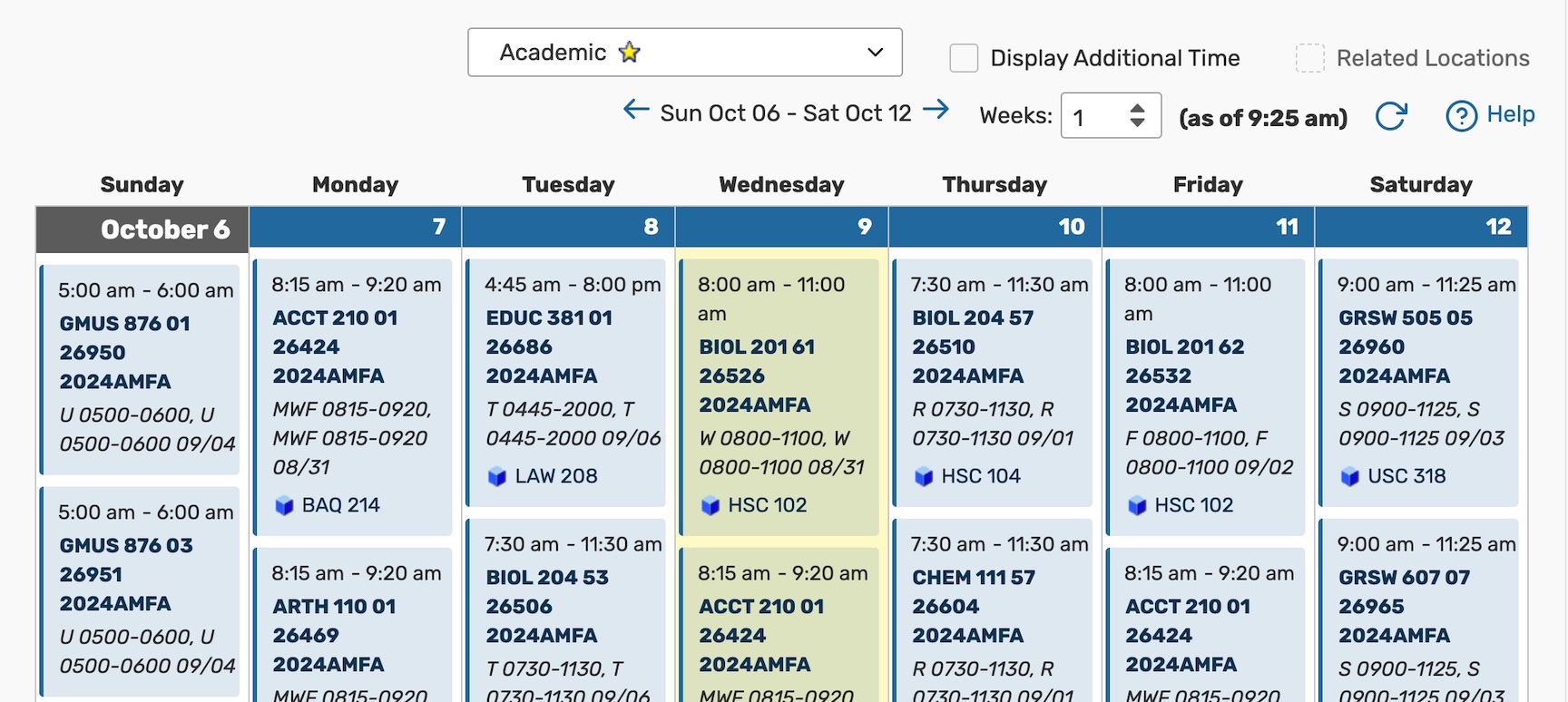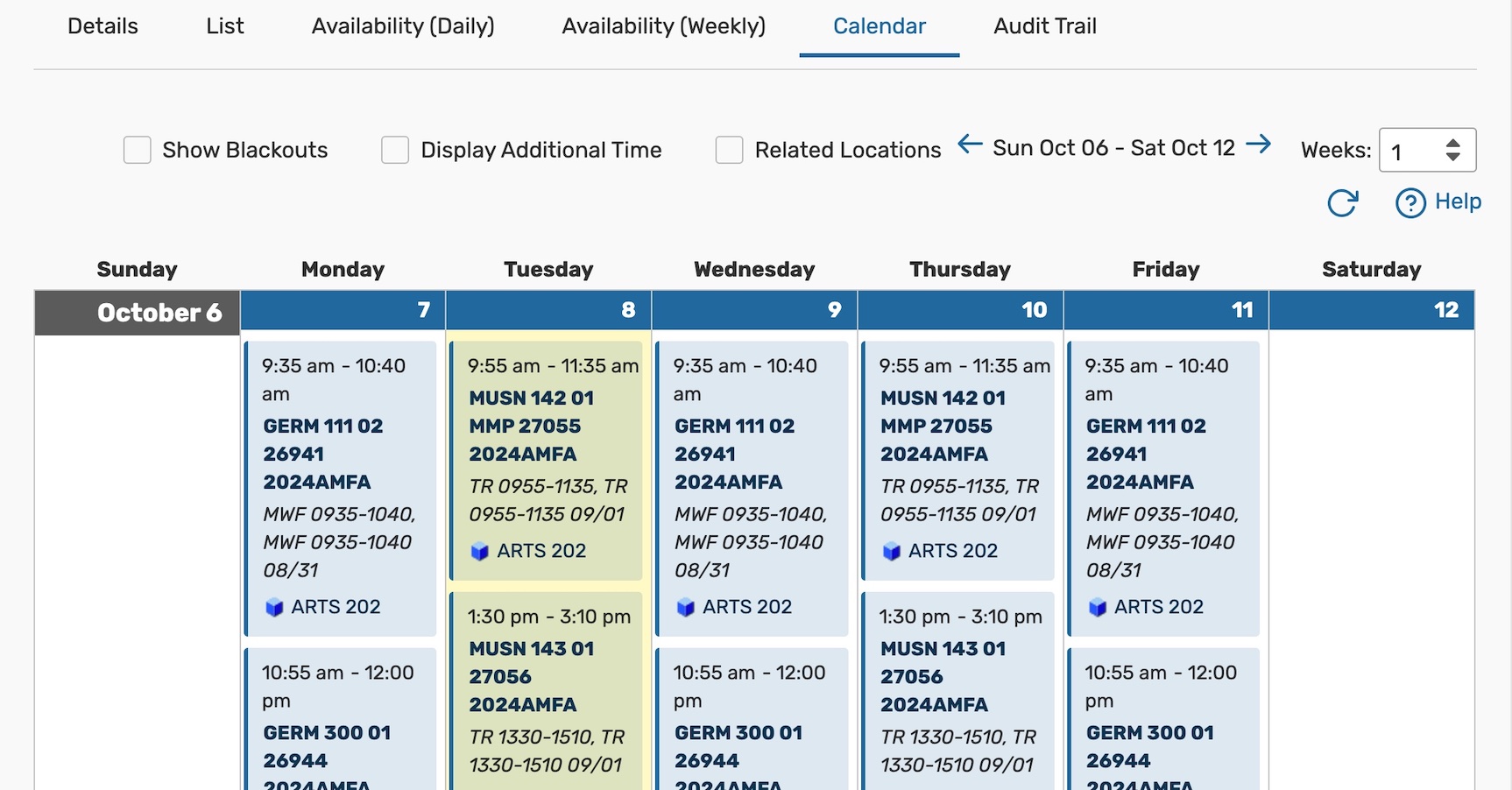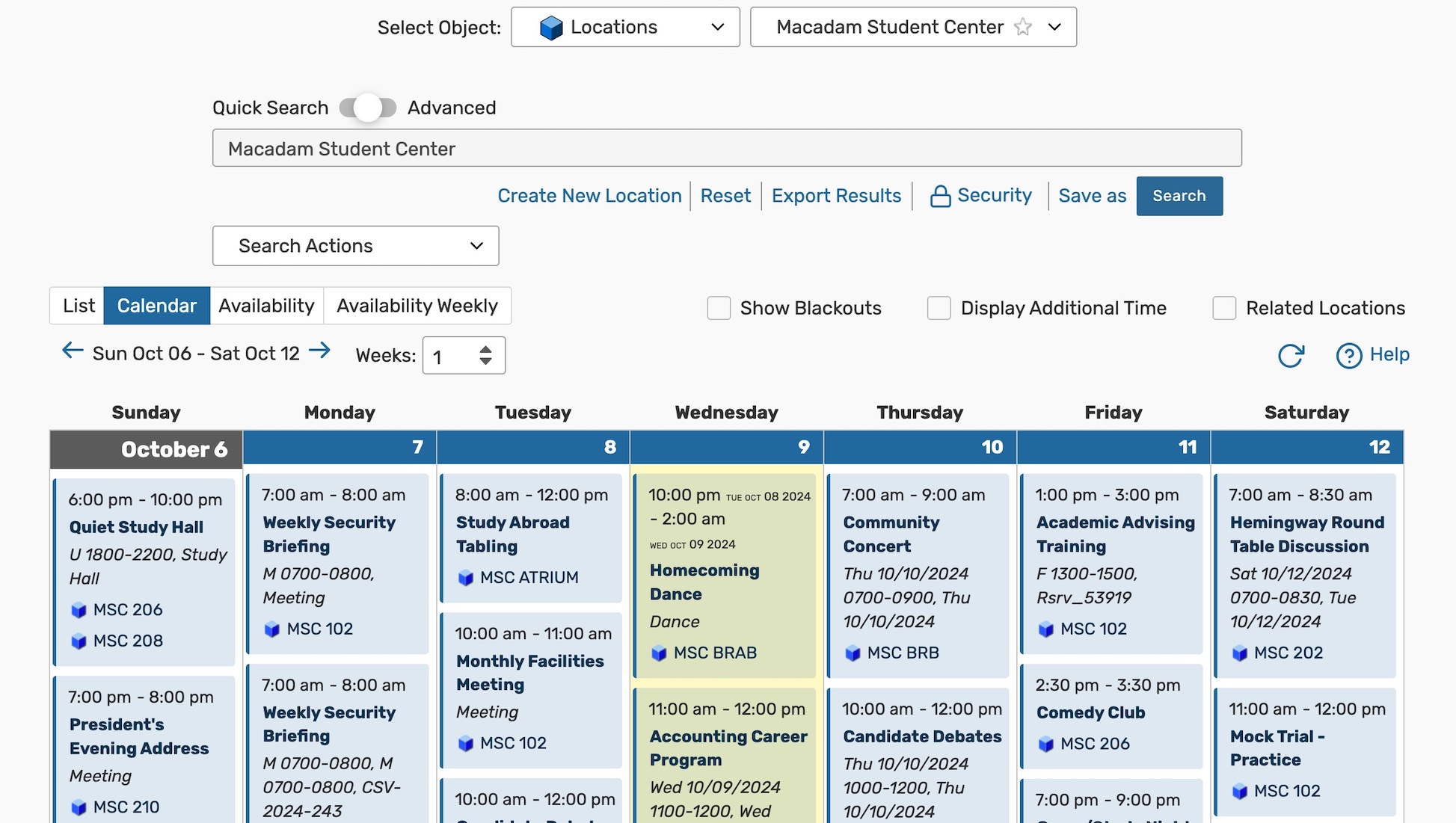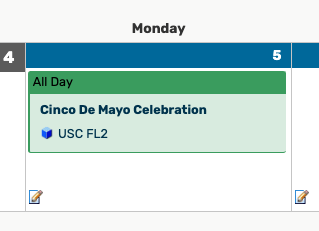Calendar views show all of the events that are returned from your search or object, displayed in an easy-to-read calendar. These views can be accessed from three main areas: a specific object details page, search results, or the 25Live More menu.
Calendar views function in nearly identical ways, with a few small differences.
Calendar Types
Default Calendar
You can get to the default Calendar by selecting Calendar from the More menu in the top navigation bar.
Default Calendar views are populated with saved searches. If no search is selected, they will use a starred object search. Once a search is selected, the calendar is populated with events that take place within the selected date range.
 Image: In this example, the Calendar view shows reservations returned from a starred event search named "Academic", that take place between October 6th and October 12th.
Image: In this example, the Calendar view shows reservations returned from a starred event search named "Academic", that take place between October 6th and October 12th.Object Calendar
Click into any 25Live location, resource, organization, or contact to move to its Details page. Then click on the Calendar tab.
Object Calendar views are available through an object's (location, resource, event, etc.) details page and are populated with events that are attached to whichever object you are viewing within a selected date range.
 Image: In this example, the Calendar view shows the events that take place in location ARTS 202, that take place between October 6th and October 12th.
Image: In this example, the Calendar view shows the events that take place in location ARTS 202, that take place between October 6th and October 12th.Search Calendar
Get to this view by running a search from the Search page and scrolling down to the results. Then select the Calendar view.
These views are populated with events generated from running an event, location, resource, organization, or task search. Unlike the default Calendar view, the search does not need to be saved to use this view.
 Image: In this example, the Calendar view shows all of the events returned after running a location search named "Macadam Student Center," that take place between October 6th and October 12th.
Image: In this example, the Calendar view shows all of the events returned after running a location search named "Macadam Student Center," that take place between October 6th and October 12th.Using the Calendar Controls
Please note that some of the buttons, dropdowns, and other controls described below are not available on every Calendar page. What you see will depend on where you are in the application.
Updating the Days Displayed
You can increase the number of days displayed by choosing a value from the Weeks dropdown. To move the dates forward or backward, use the arrow buttons, or click on the date text to open the calendar picker.
 Image: You can move the displayed timeframe forward and backward using the arrow buttons or change the range by clicking on a date.
Image: You can move the displayed timeframe forward and backward using the arrow buttons or change the range by clicking on a date.Additionally, you can move forward and backward by a week using the arrow buttons below the calendar.
 Image: Use the forward and backward arrows below the calendar to move the calendar range by a week.
Image: Use the forward and backward arrows below the calendar to move the calendar range by a week.Refreshing the Results
If any changes have been made that now meet or no longer meet the calendar criteria, press the refresh button to update the results.
 Image: Press the refresh button if recent changes are missing from the calendar.
Image: Press the refresh button if recent changes are missing from the calendar.
If the calendar view that you are using has the time listed in parentheses, the refresh time will be reflected there.
 Image: The time displayed will reflect the last time the calendar was refreshed.,
Image: The time displayed will reflect the last time the calendar was refreshed.,Grouping Tasks
On task search calendars, use the Group Calendar By dropdown to sort calendar events by the task's Respond By date (also known as the Due Date) or the task's occurrence date.
 Image: Group Calendar By allows you to choose how to sort a task calendar.
Image: Group Calendar By allows you to choose how to sort a task calendar.Displaying Location Blackouts
Check the Show Blackouts box to include blocks of location blackout time on the calendar.
 Image: Check the box to see location blackouts.
Image: Check the box to see location blackouts.Displaying Additional Time
Check the Display Additional Time box to see pre, post, setup, and takedown time displayed on your calendar events.
 Image: Check the box to see additional time.
Image: Check the box to see additional time.Displaying Related Location Dates
Select the Related Locations checkbox on location calendars to display events that take place in locations configured in the Related Spaces section of the location Details.
 Image: Check the box to see related locations in the calendar results.
Image: Check the box to see related locations in the calendar results.Displaying Related Event Dates
Select the Related Events checkbox on event calendars to display related events on the calendar.
 Image: Check the box to see related events in the calendar results.
Image: Check the box to see related events in the calendar results.Reading and Interacting With Calendar Events
Calendar events will include always include the event name and time (which may be set to All Day). Depending on where you are viewing the calendar, your settings, and how much information is available for the event, you may also see the event's meeting pattern, additional time, a registration link, associated location(s), associated resource(s), and/or associated organization(s).
Note: All Day Events
Events that run from midnight to midnight (excluding additional time) in your user preference timezone will display on calendars All Day events.
 Image: Example of an All Day event on a calendar.
Image: Example of an All Day event on a calendar.An event is considered an all day event in the region where the event takes place. If your timezone is different from the system timezone or another user’s timezone, the banner will not apply when using the "All Day" flag in the event form.
Event, location, resource, and other objects on calendars are interactive.
- Click on an object link to move to its Details page.
- Hover over an object link to see a summary of its details.
- Right-click on an object to see more actions.
 Animation: Calendars are interactive. Hover, left-click, and right-click on links to see more information.
Animation: Calendars are interactive. Hover, left-click, and right-click on links to see more information.If your event has registration available, users can register directly from the calendar event by clicking the link.
 Image: A Register link will display on an event if the event is setup to allow registration and the logged in user has the appropriate rights to register.
Image: A Register link will display on an event if the event is setup to allow registration and the logged in user has the appropriate rights to register.Creating Events From the Calendar
Calendar views allow you to create events using the paper and pencil icon ( ) right from the calendar grid. If a location is setup for Express Scheduling, clicking the icon will bring up the Express Scheduling form for quick event creation. Use the Open in Form button to use create your event in the standard Event Form instead.
) right from the calendar grid. If a location is setup for Express Scheduling, clicking the icon will bring up the Express Scheduling form for quick event creation. Use the Open in Form button to use create your event in the standard Event Form instead.